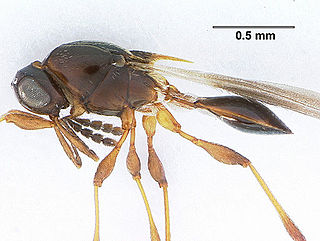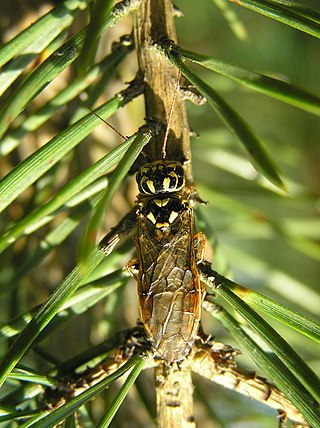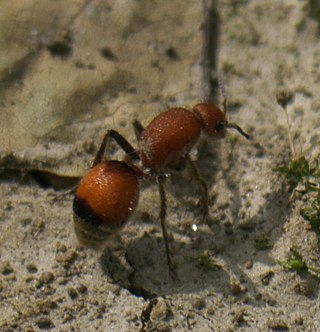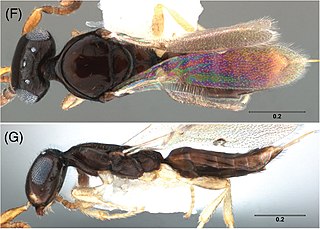
The Hymenopteran superfamily of parasitoid wasps, Platygastroidea, has often been treated as a lineage within the superfamily Proctotrupoidea, but most classifications since 1977 have recognized it as an independent group within the Proctotrupomorpha. It is presently has some 4000 described species. They are exclusively parasitic in nature.

The hymenopteran family Platygastridae is a large group of exclusively parasitoid wasps, mostly very small (1–2 mm), black, and shining, with geniculate (elbowed) antennae that have an eight-segmented flagellum. The wings sometimes lack venation, though they may have slight fringes of setae.

The Pamphilioidea are a small superfamily within the Symphyta, containing some 250 living species restricted to the temperate regions of Eurasia and North America. These hymenopterans share the distinctive feature of a very large, almost prognathous head, which is widest ventrally.

The Tenthredinoidea are the dominant superfamily of sawflies within the Symphyta, containing some 8,400 species worldwide, primarily in the family Tenthredinidae. All known larvae are phytophagous, and a number are considered pests.

Trigonalidae is one of the more unusual families of hymenopteran insects, of indeterminate affinity within the suborder Apocrita, and presently placed in a unique superfamily, Trigonaloidea, and the only extant taxon in the superfamily. The other putative related taxon is the extinct family Maimetshidae, known from the Cretaceous period. Trigonalidae are divided into 2 subfamilies; Orthogonalinae and Trigonalinae. These wasps are extremely rare, but surprisingly diverse, with over 90 species in 16 genera, and are known from all parts of the world. It is possibly the sister group to all Aculeata.

The hymenopteran family Scelionidae is a very large cosmopolitan group of exclusively parasitoid wasps, mostly small (0.5–10 mm), often black, often highly sculptured, with (typically) elbowed antennae that have a 9- or 10-segmented flagellum. It was once considered to be a subfamily of the Platygastridae, but has been revived in the most recent classification of Platygastroidea.

Scelio is a large genus, the largest within the family Scelionidae, of parasitic wasp whose known target host include the eggs of grasshoppers. They are found worldwide and some species have been implemented as biological control agents.
Calliscelio is a parasitoid wasp monotypic genus which contains one species, C. elegans. It was first described as Caloteleia elegans on Oahu in the Hawaiian Islands in 1910 by British entomologist Robert Cyril Layton Perkins, who believed it not to be an indigenous species of Hawaii. Its pantropical species distribution is now well-established and it is still considered to be an adventive species in Hawaii. C. elegans was reassigned from its original genus to Caenoteleia in 1926 by French entomologist Jean-Jacques Kieffer and then to Calliscelio in 2009.

Maaminga is a genus of parasitic wasps containing two species and constituting the family Maamingidae. So far only known from New Zealand, the two named species are Maaminga marrisi and M. rangi. The genus name derives from the Māori word "māminga", simply translated as "trickster" as the species evaded discovery for so long.

Pompiloidea is a superfamily that includes spider wasps and velvet ants, among others. in the order Hymenoptera. There are 4 families in Pompiloidea.
Idris is a genus of parasitic wasps in the family Platygastridae, containing about 160 described species. This genus is part of the tribe Baeini, which are egg parasitoids. Members of the genus Idris are mostly parasitoids of spider eggs, but at least one member of the genus uses stink bugs as hosts.

Proterosceliopsis is an extinct genus of platygastroid parasitic wasp, known from the Mid-Cretaceous of Eurasia. The genus was first described in 2014 from the Albian amber of the Escucha Formation. In 2019 additional species were described from the Cenomanian-age Burmese amber, and was placed into the monotypic family Proterosceliopsidae.

Pachyrhamma edwardsii is a species of wētā, in the family Rhaphidophoridae, endemic to New Zealand. This species is found in caves, or large cavities where there is high humidity and little plant or animal life.
Sparasion is a genus of wasps belonging to the family Sparasionidae, whitin the superfamily Platygastridae. The genus has specimens widespread in Eurasia, Africa, and temperate North America.
In ecology, a tramp species is an organism that has been spread globally by human activities. The term was coined by William Morton Wheeler in the bulletin of the American museum of natural history in 1906, used to describe ants that “have made their way as well known tramps or stow-aways[sic] to many islands The term has since widened to include non-ant organisms, but remains most popular in myrmecology. Tramp species have been noted in multiple phyla spanning both animal and plant kingdoms, including but not limited to arthropods, mollusca, bryophytes, and pteridophytes. The term "tramp species" was popularized and given a more set definition by Luc Passera in his chapter of David F William's 1994 book Exotic Ants: Biology, Impact, And Control Of Introduced Species.

Nixonia is a genus of wasps. It is the only member of the family Nixoniidae in the superfamily Platygastroidea. They are amongst the largest of the platygastroids at up to 9 mm in length. Members of the genus are known from Africa, the Indian subcontinent and Southeast Asia. The biology of only one species is known, which parasitises orthopteran eggs.

Janzenella is a genus of wasp, the only member of the family Janzenellidae within the superfamily Platygastroidea. It contains only a single living species, Janzenella innupta, which has only been collected in Costa Rica. Fossil members of the living species have also been described from Miocene aged Dominican amber. A Late Eocene fossil species, Janzenella theia is known from specimens entombed in Baltic amber.

Geoscelionidae is a family of wasps in the superfamily Platygastroidea. It contains three extant species in two genera, native to South America and Africa, and several other genera known from fossils. It was originally erected as the tribe Geoscelionini within Scelionidae. It was raised to a full family in 2021.

Sparasionidae is a family of wasps in the superfamily Platygastroidea. Known species are parasitioids of the eggs of orthopterans.















